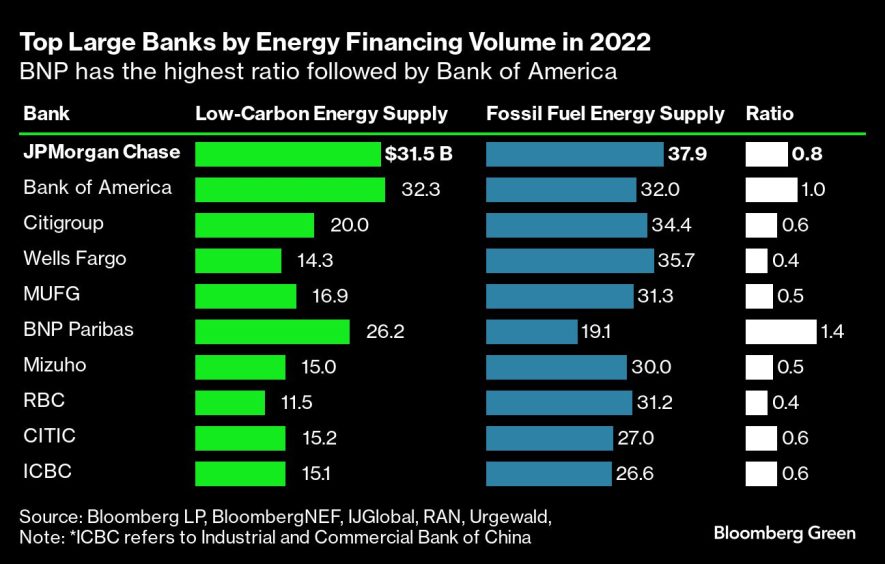The world’s largest banks are showing little or no progress when it comes to their promise to help the world avoid the worst consequences of global warming.
According to researchers at BloombergNEF, the ratio of spending on low-carbon infrastructure relative to fossil fuels needs to reach 4 to 1 by 2030. At the end of last year, the so-called energy-supply banking ratio, which includes debt and equity underwriting, was 0.73 to 1—slightly worse than the 0.75-to-1 ratio reported in 2021.
“We didn’t see significant growth in the ratio of low-carbon financing to fossil fuels,” said Trina White, sustainable-finance analyst at BNEF. “Neither real-economy investment nor bank financing are anywhere close to the immediate and rapid scale-up in low-carbon capital flows and phase-down of fossil fuels that we need to see.”
The latest BNEF data show that last year’s investment in energy-supply sources, including low-carbon projects, increased to $2 trillion from $1.8 trillion in the prior year, while bank financing for both fossil fuels and low-carbon energy actually declined. Interest rates are seen as the reason.
“The divergence between real-economy spending and bank financing can in large part be explained by the interest-rate environment,” White said. “In regions where borrowing costs went up, companies’ demand for bank-facilitated capital plummeted. Meanwhile, those companies—both low-carbon and fossil fuels—had lots of their own cash flows available to spend while they borrowed less.”
The BNEF report comes a day after the announcement at COP28 in Dubai that delegates pledged to move away from fossil fuels—though with no binding requirements and vague language aimed at appeasing petrostates.
The summit’s final text also indicated that natural gas, a fossil fuel that’s somewhat less carbon-intensive than oil and coal, will continue to be a big part of the global energy economy. It also placed CO2 capture and storage alongside renewables and nuclear as key technologies that would drive the transition, though technology to make carbon capture work at scale has yet to be perfected.
BNEF’s research shows that any headway made to date by banks isn’t nearly enough for the planet to reach the crucial goal of net-zero emissions by midcentury. Since the clinching of the Paris Agreement at the end of 2015, about $5.1 trillion of bonds and loans have been committed to businesses focused on hydrocarbons, compared with the $2.9 trillion arranged for renewable projects and other climate-friendly ventures, according to data compiled by Bloomberg.
JPMorgan Chase & Co., the world’s largest underwriter of energy deals, had an energy-supply banking ratio (ESBR) of 0.83 in 2022. That’s worse than BNP Paribas SA and Bank of America Corp., but better than Wells Fargo & Co.’s 0.4 and Citigroup Inc.’s 0.58. BNP Paribas had the highest ESBR of the 10 largest banks, at 1.37.
Banks have faced considerable criticism for continuing to profit handsomely from their partnership with Big Oil in the face of a planetary climate crisis. Industry executives have sought to defend themselves by saying they want to assist in the transition to a low-carbon economy by staying engaged with their oil, gas and coal clients.
However, any such efforts appear to be happening at a dangerously slow pace—even in an environment where investment in energy supply, including low-carbon sources, has been increasing.
The BNEF data provide one of the few yardsticks for measuring progress, since hardly any major banks and asset managers provide estimates for the emissions connected with their stock and bond underwriting. But that may soon change. The Partnership for Carbon Accounting Financials, a global alliance of banks and asset managers that develops climate accounting guidelines for financial services, this month backed a first-ever industry standard. That means banks will no longer be able to totally ignore the carbon footprint of their capital-markets activities.
The PCAF guidelines—though an industry initiative rather than an independent one—are designed to underpin net zero plans by calling for banks to disclose 33% of greenhouse-gas emissions associated with their bond and equity underwriting.
As for the BNEF study, it examined the loans, bonds, equity and project financing that were underwritten for the energy sector and other relevant issuers. The researchers also included tax equity, which represents a growing share of renewables-project finance—particularly in the US.
BNEF then applied what it calls an adjustment factor to estimate the amount of funding raised for low-carbon energy relative to fossil fuels. It looked at roughly 1,000 banks engaged in some form of supply underwriting.
The analysis found that bank financing for energy supply totaled $1.7 trillion in 2022, with $708 billion going to low-carbon energy projects and companies and $967 billion for fossil fuels. From these figures, BNEF came up with an energy-supply banking ratio of 0.73 for the industry.
Of the 20 largest banks ranked by financing volume, none had an ESBR close to 4.0. Barclays’ ratio was the highest, at 1.55. Bank of Nova Scotia’s was the lowest, at 0.32.
Regionally, the US and China are far behind Europe. And while banks in North America accounted for the largest share of energy-supply financing, their average ESBR was roughly 0.5 at the end of 2022, compared with 2.8 for European-based banks. Chinese banks had an average ESBR of 0.6.
The divergence reflects “the relative paucity of oil and gas supply in Europe and the continent historically having the most favorable regulatory environment for low-carbon energy investment,” according to the BNEF report. By contrast, the US, Canada and Mexico play “a major role in the supply of energy, particularly oil and gas, for domestic and export use.”
China dominates coal financing. All of the 10 largest coal-underwriting banks are based in China, with 76% of the global flows concentrated in the country, according to BNEF.
Recommended for you




 © Bloomberg
© Bloomberg © Bloomberg LP, BloombergN
© Bloomberg LP, BloombergN






